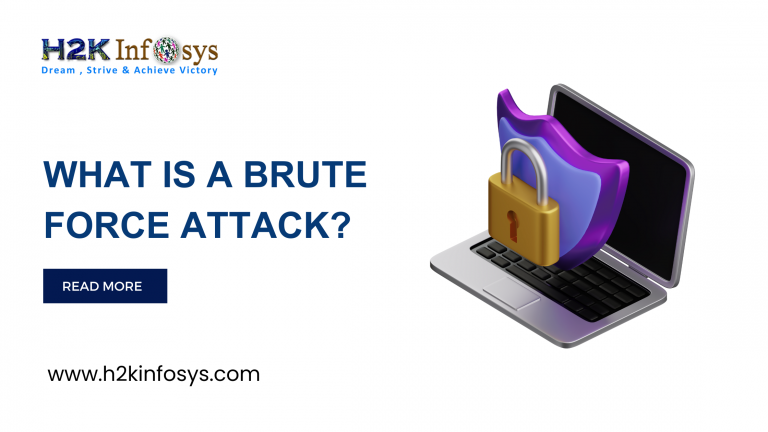A brute force attack is a type of account takeover attack. It makes an effort to deduce passwords and other secrets that would allow access to content that is prohibited by using trial and error.
An attacker using a brute force attack attempts every password or other secret value in an effort to find the right one. Although the success of these assaults is inevitable, they can be prevented by employing multi-factor authentication (MFA) or creating strong passwords. Check out the cyber security online training to learn more.
How Does a Brute Force Attack Work?
The foundation of a brute force attack is the expectation that the attacker would eventually figure out the password, assuming one exists. If a user has an eight-character password, for instance, an attacker will eventually get the right password if they attempt every possible eight-character combination. The primary drawback of brute force attacks is their potential for high execution times. A lengthy random password may take millions of years or longer to crack, even if automated brute forcing techniques can attempt several passwords per second.
Nevertheless, this degree of security is sometimes absent from passwords, which makes brute force an effective attack vector. If the attacker is able to figure out the right password, they can access the user’s account and steal money or data, or they can infect systems with malware, or take other malicious actions.
Types of Brute Force Attacks
The process of trying different password guesses until the attacker finds the right one is known as a brute force attack. Brute force attacks come in a few varieties, such as:
- Simple Brute Force Attack: The attacker thoroughly examines each potential password candidate in a basic brute force attack. They might attempt aaaaaaaa, aaaaaaaab, etc. as examples.
- Dictionary Attack: A dictionary attack uses password breaches and a list of frequently used dictionary terms as its starting point. These passwords are frequently also subjected to basic manipulations, including changing special characters (@ for a, etc.) or appending numbers at the end of words.
- Hybrid Brute Force Attack: A dictionary attack and a basic brute force attack are combined to create a hybrid brute force attack. When it fails, the attacker uses a dictionary to attempt to guess the user’s password before switching to a straightforward brute force attack.
- Reverse Brute Force attack: In this type of assault, the attacker begins with a password that is widely used or known. After that, they look for usernames that have that password.
- Credential Stuffing Attack: In this type of attack, the attacker attempts to use credentials that have been compromised for one website on multiple websites. This makes an effort to find passwords that are reused on several accounts.
How to Prevent Brute Force Password Attacks
The possibility of a successful account takeover exists with brute force password guessing assaults. Among the strategies to defend against these dangers are:
- Strong Passwords: The foundation of brute force password attacks is the ability to guess a password in a reasonable length of time. A brute force assault takes longer and requires more complexity when a long, random password is used.
- Salted Hashes: Prior to hashing and saving a password, salting entails mixing each one with a distinct random value. This makes it harder to discover and crack passwords by preventing identical passwords from having identical password hashes.
- Rate Limiting: Passwords are tested against a live login page in online brute force assaults. By putting rate limiting into practice, or simply permitting a specific amount of login requests per minute, these attacks become slower and less effective.
- Account Lockouts: After a certain amount of unsuccessful login attempts, account lockouts prohibit access to a user’s account, even with the proper password. With only a few guesses remaining, an attacker’s chances of success are drastically decreased, effectively disincentivizing brute force attacks.
- Two-Factor/Multi-Factor Authentication (2FA/MFA): In order to access a user’s account, 2FA/MFA requires two or more distinct authentication factors. For instance, MFA might make it necessary for an attacker to figure out or obtain both the password and the one-time password (OTP) that an authenticator software generates.
- Behavioural Analytics: A company can utilise behavioural analytics to spot unusual activity associated with user accounts. An attempt at a brute force password guessing attack, for instance, is indicated by a high volume of unsuccessful login attempts.
- IP Blocklisting: Also, a hacker has the ability to specifically stop traffic coming from known malicious IP addresses. This may make it more challenging for a botnet to launch a brute force assault designed to guess a password.
Conclusion
In recent years, the environment of cyber threats has drastically changed. Although brute force attacks are not as new as they once were, they are still a concern thanks to contemporary technologies. Consequently, there is an increased likelihood for a brute force attacker to obtain access to a user’s account and pilfer funds or data.
Account takeover is just one type of cyberattack that businesses must deal with, though. Check out Check Point’s 2023 Mid-Year Cyber Security Report for additional details on the state of cyber threats today. Organizations now have to contend with the Fifth Generation of cyberattacks, which are more sophisticated and greater in scope. Learn more about protecting against the Gen V cyber threat with the cyber security online course.






























